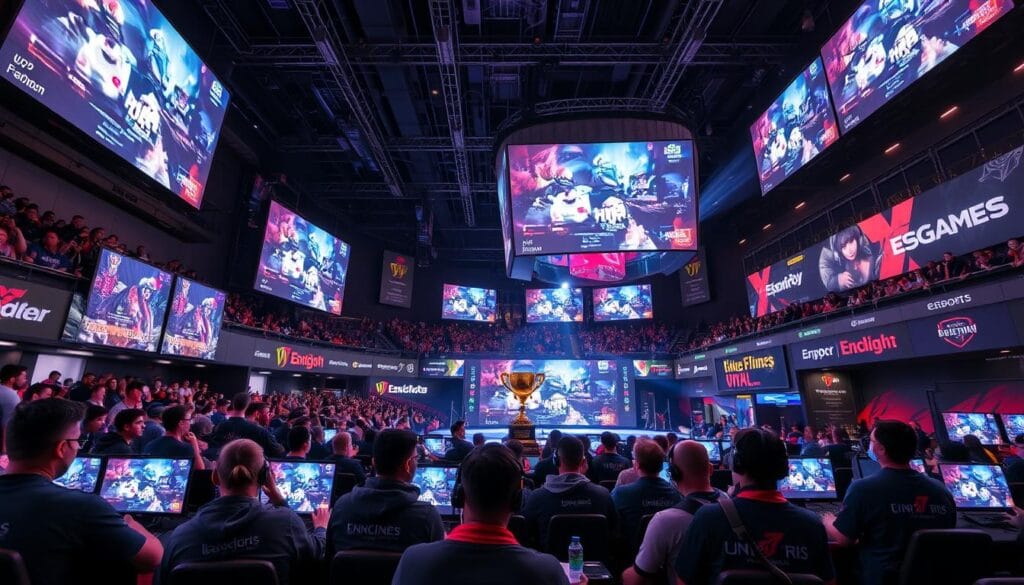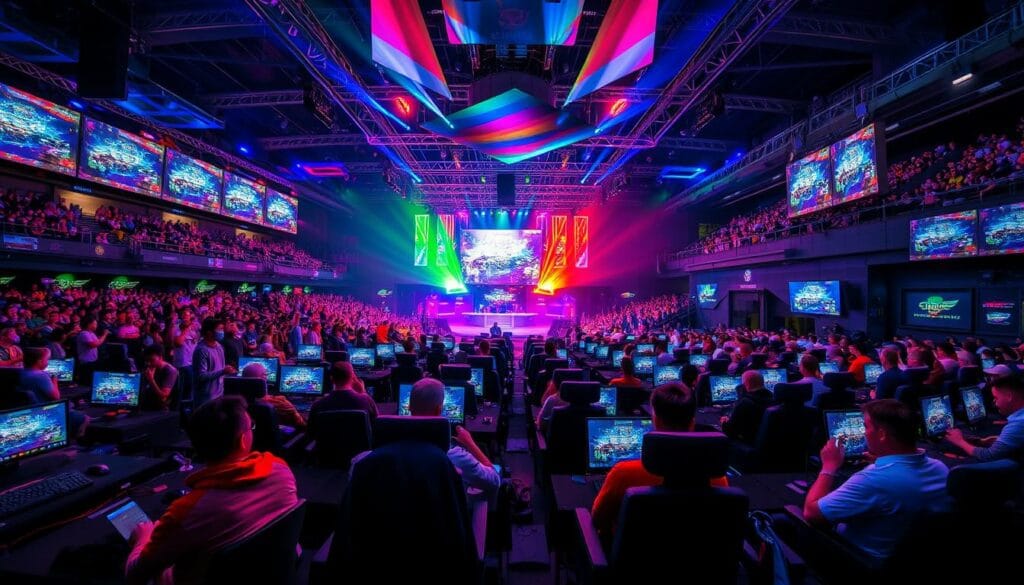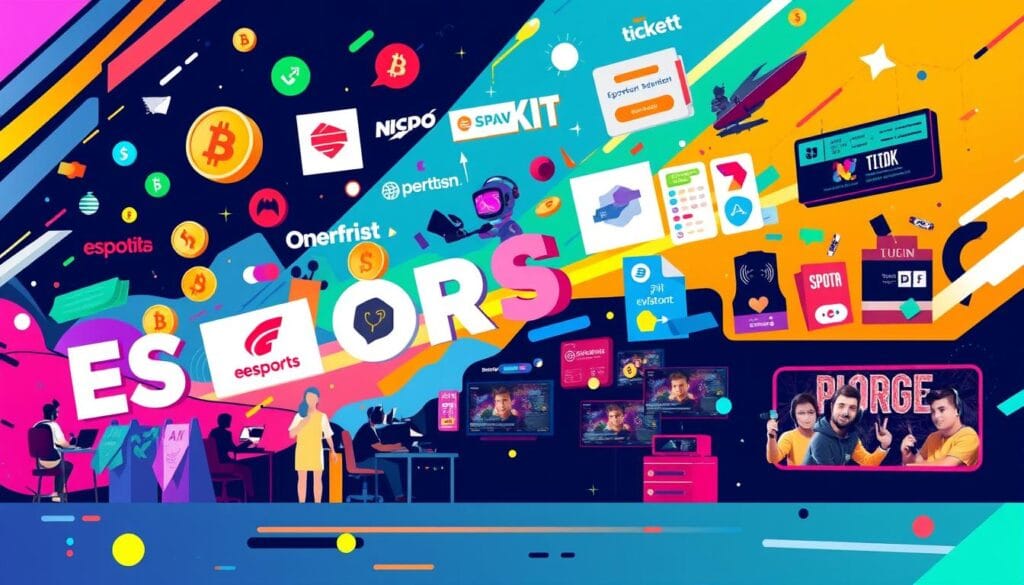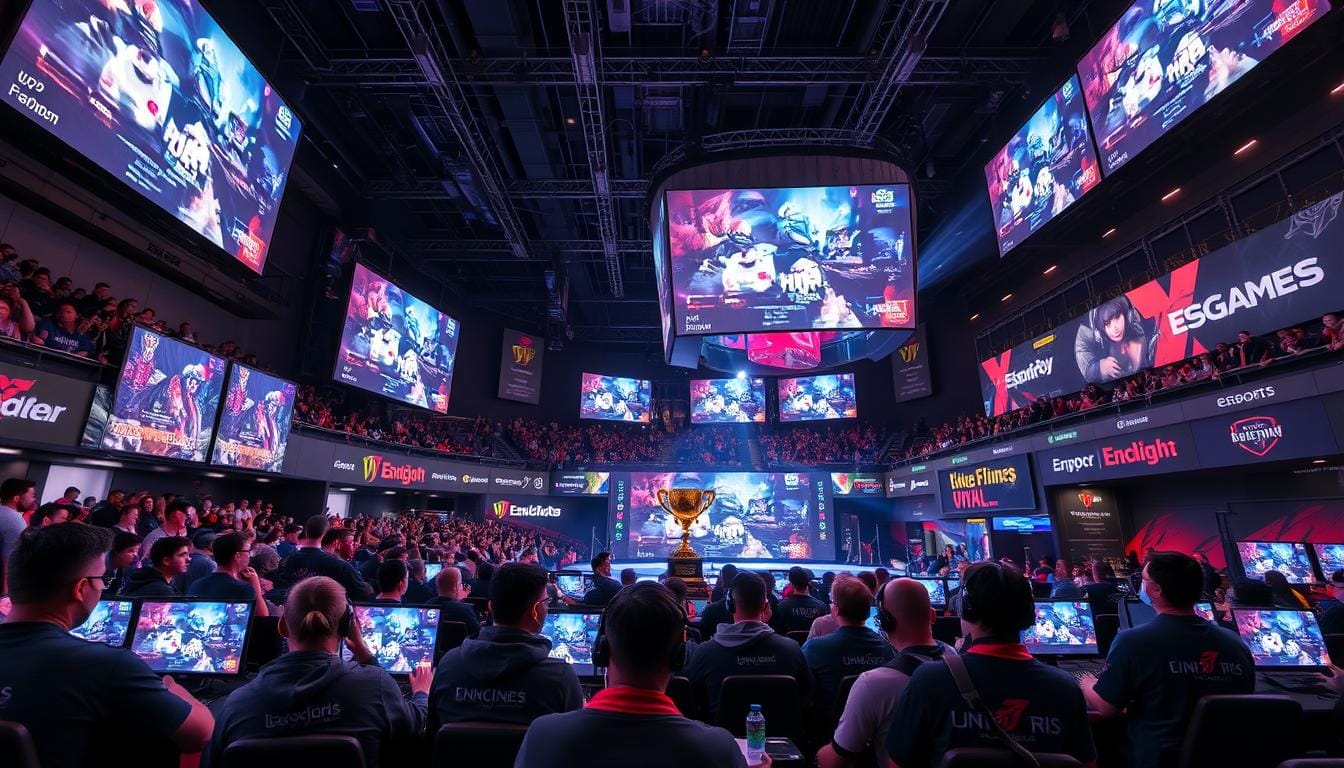Analyzing the Impact of Esports on the Gaming Industry
I’ve been a gamer my whole life. I’ve seen the gaming world change a lot in the last ten years. What started as a small hobby has grown into a huge global phenomenon called esports. It’s a world where playing games for fun and competing at a high level are now the same thing.
This change has not only made gaming more exciting. It has also changed the gaming industry in big ways.

Table of Contents
The Evolution of Competitive Gaming
The world of professional gaming, or esports, has changed a lot in recent years. It started as simple arcade games but now it’s a huge global event. It has professional leagues, big prize money, and lots of fans.
From Arcade Competitions to Professional Leagues
Esports started back in the 1980s. Atari held a big tournament in 1980 where 10,000 gamers competed. Only four made it to New York City for the final.
In the 1990s, Nintendo World Championships showed how competitive gaming was growing. It had different age groups, showing the interest was real.
The 2010s were a big time for esports. Events like the League of Legends Championship Series (LCS) in 2013 made it big. Now, games fill stadiums and arenas worldwide.
Milestones in Esports History
- Games like Counter-Strike: Global Offensive (CS:GO), Valorant, and Fortnite have drawn in millions.
- Tournaments now offer prizes over $1 million, drawing top players from everywhere.
- Big names like Logitech, Razer, and Intel support esports with their products.
The Rise of Global Gaming Communities
The professional gaming culture has grown, so have its fans. People from all over have joined, creating a worldwide community. This community supports the different esports tournament formats out there.

“Esports has grown from a specialized interest into a worldwide cultural movement, drawing millions of enthusiasts and players globally.”
Understanding the Economics of Esports
The esports industry has grown a lot in recent years. It has become a cornerstone of the broader gaming community. Now, there are many ways to make money, like sponsorships, media rights, merchandise, and ticket sales.This boom has attracted investment from sports franchises, celebrities, and venture capital firms.
In 2005, the Cyberathlete Professional League World Tour offered a $1 million prize pool. By 2021, the prize pool for The International Dota 2 tournament had surged to over $40 million. This shows how much money esports can make.
The top esports clubs are now worth over $3 billion together. The global esports industry saw a 10% growth in 2022. It’s expected to grow even more, with a 13.8% annual growth rate for the next five years.
Esports also creates jobs in event management, content creation, and tech. This helps the gaming industry grow too.
New esports facilities, like the Esports Stadium Arlington, are being built. Even old venues, like the Memorial Auditorium in Worcester, Massachusetts, are being updated. This helps the esports world grow.
“Currently worth $2 billion, the esports industry is projected to exceed $5 billion by 2029, marking significant growth.”
Esports isn’t just big in North America. Mobile esports is growing fast in places like the Middle East and North Africa (MENA). This global growth shows esports is a big part of the gaming world’s success.

Esports Impact on Traditional Gaming Development
Esports has changed traditional gaming a lot. Now, games are made for competitive play.These platforms are designed with features catering to professional gamers and esports enthusiasts alike.
Game Design Changes for Competitive Play
Game designers focus on making games balanced and fair. They add matchmaking systems and spectator modes. These help create a great esports scene.
They also try new gameplay and interfaces. This makes the esports experience better.
Balancing Entertainment and Competition
Developers face a big challenge. They need to make games fun for everyone and competitive for pros. It’s key for the gaming and esports worlds to grow.
Innovation in Gaming Technology
Esports pushes gaming tech forward. Developers explore VR and AR for better experiences. These could change how we play and watch games.
Esports has really changed gaming. Game designers keep improving to meet esports needs. This growth in esports and gaming tech is exciting.
Professional Gaming Culture and Career Opportunities
In the world of professional gaming, a vibrant culture has grown. It celebrates skill, teamwork, and strategic thinking. The esports industry’s growth has created many career paths beyond just playing games.New roles, such as coaches, analysts, commentators, and content creators, have become integral to the ecosystem.
Esports programs at universities have become popular. There are now over 200 collegiate esports programs across the United States. offer scholarships. This shows growing support for esports. Universities worldwide now offer esports majors and scholarships, making esports a real career option.
The esports industry is also a big economic driver. Revenue for the industry is generated through media rights, advertising, sponsorships, merchandise, and ticket sales. This has created jobs in many areas, from game development to marketing. It shows a bright future for those who combine their gaming passion with career goals.
| Esports Event | Economic Impact |
|---|---|
| ESL FaceIt’s IEM Cologne | $29 million |
| IEM Dallas and DreamHack Dallas | $25 million |
| IEM Rio 2022 | $40 million |
Esports events do more than just make money. They bring communities together, add cultural value, and inspire young people. As the industry grows, the future of professional gaming looks very promising.
“Esports scholarships create pathways to diverse careers in gaming, including professional players, game developers, coaches, and marketing specialists.”
Broadcasting and Streaming Revolution in Gaming
The rise of esports has changed how we watch and share gaming content. Platforms like Twitch and YouTube Gaming are now key in the esports world. They make competitive gaming accessible to everyone, drawing in fans from all over.
Popular Streaming Platforms
Twitch leads the way in esports broadcasting. It’s known for live gaming content. Now, people worldwide can watch esports tournaments live from home.
Twitch streams offer great viewing experiences. They include different camera angles and live stats. This makes watching esports more engaging for fans.
Content Creation and Monetization
Twitch’s accessibility has helped esports grow fast. Streamers and pro gamers can now build their brands. They connect with fans and find new ways to make money through sponsorships and donations.
This has created a thriving community in esports. It drives more engagement and helps build strong fan bases.
Virtual Reality and Future Broadcasting
Virtual reality (VR) is set to change esports broadcasting even more. It promises a more immersive experience. Fans could feel like they’re right in the game.
VR, along with cloud gaming and 5G, points to an exciting future. It will blur the lines between players, creators, and viewers.
“Streaming has catapulted esports from a niche interest to a worldwide sensation, giving players, creators, and fans the power to shape the future of competitive gaming.”
Tournament Structures and Competition Formats
Esports has grown from small online events to huge global competitions with big prizes. Now, there are many different formats for esports tournaments. Each one is designed to draw in viewers and create fierce competition.
The League of Legends (LoL) World Championships is a big name in esports. his event has been a yearly occurrence since its launch in 2011. Over time, nine teams have won the championship, showing how competitive the scene has become.
In 2023, the LoL Worlds introduced a new Swiss-style format for the group stages. Teams need to win three matches to move on to the knockout rounds. This change aims to get rid of tiebreakers and make sure teams advance based on their wins.
| Tournament Format | Description | Advantages |
|---|---|---|
| Single Elimination | Teams are eliminated after a single loss. | Concise, clear tournament structure, fast-paced action. |
| Double Elimination | Teams are eliminated after two losses. | Allows for more matches and increased competitiveness. |
| Round-Robin | Teams play against each other in a set number of matches. | Ensures a more comprehensive evaluation of team performance. |
| Swiss System | Teams face opponents with similar records, leading to progressive advancement. | Reduces the need for tiebreakers, maintains competitive integrity. |
These new tournament structures and the digital nature of esports are driving the industry’s fast growth and global appeal. As esports tournament formats keep evolving and competitive gaming growth speeds up, the future looks bright and full of possibilities.
“The unpredictability of bracket-based tournaments keeps audiences hooked, while interactive bracket challenges enhance fan engagement and excitement.”
The Role of Sponsorships and Advertising
The esports world is a big stage for brands to meet a tech-loving audience. Sponsorships and ads are key to its growth. It’s important for both esports groups and brands to know how to work together well.
Brand Integration in Esports
Esports lets brands blend into the gaming world in many ways. This includes team sponsorships and in-game ads. Even non-gaming brands see the value in reaching out to esports fans, making the sponsorship scene more diverse.
Marketing Strategies and ROI
Good esports marketing means knowing the community well and being real. Brands that connect with fans in a true way tend to do well. Using influencers, creating content, and sponsoring events are key strategies for success.
Partnership Opportunities
The esports world offers many partnership chances, not just sponsorships. Companies like hardware makers and sports groups team up with esports. These partnerships help both financially and by reaching new audiences.
As esports grows, sponsorships and ads will play an even bigger part. Brands that get esports right can see big wins in awareness, engagement, and revenue.
| Key Esports Revenue Streams | 2022 (Estimated) | 2024 (Projected) |
|---|---|---|
| Sponsorships and Advertising | $800 million | $1 billion |
| Media Rights | $208 million | N/A |
| Ticket Sales | $100 million | N/A |
| Total Esports Revenue | $1.1 billion | $1.577 billion |
The esports industry is growing fast, with sponsorships and ads at the heart of its success. Brands that can connect well with esports fans will benefit from this booming market.
Global Audience Engagement and Demographics
Esports has won over a diverse, global audience, mainly millennials and Generation Z. These fans are not just spectators. They dive into interactive streaming, fantasy leagues, and social media. This shows their deep engagement with esports.
The growth of esports is impressive. Top-tier esports events draw millions of viewers from all over the globe. The global market is over $1 billion as of 2023.Esports viewership is anticipated to surpass 577.2 million worldwide by 2024
Esports varies by region. Asia-Pacific, especially China and South Korea, makes up nearly 50% of the audience. But North America, Europe, and Latin America are also growing fast. Marketers need to adapt to these different tastes and habits.
Mobile esports is a big factor in growth, especially in new markets. Smartphones are the go-to for many fans. The esports market in Southeast Asia is projected to see remarkable growth, with an estimated annual increase of 20.8% by 2024.
| Region | Esports Market Size (2024 Projected) | CAGR (2019-2024) |
|---|---|---|
| North America | $1.07 billion | 15.4% |
| Europe | $1.44 billion | N/A |
| South Korea | $297.2 million | 6.68% |
| China | $497.6 million | 4.61% |
| Southeast Asia | $79.7 million | 20.8% |
Esports fans love online streaming, like Twitch and YouTube, more than TV. This has created new chances for brands to fit into the gaming world. It’s boosting esports fan engagement strategies and esports viewership trends.
“The global market for esports and game streaming was valued at $2.1 billion in 2021, and it is anticipated to surpass $3.5 billion by 2025, reflecting a remarkable 70% growth.”
Technology Infrastructure Supporting Esports Growth
The gaming world is booming, and esports is growing fast. This growth is thanks to new tech like special hardware, strong networks, and cool software. These changes help esports keep up with the fast pace of competitive gaming.
Hardware Requirements
Esports players need top-notch gaming computers. These computers have fast processors, quick graphics cards, and clear displays. They also use special mice, keyboards, and headsets for better control and speed.
Network Infrastructure
Good internet is key for esports. It lets players play smoothly online and join global tournaments. Countries with fast, reliable internet are better at growing esports talent and hosting big online events. Plans for high-speed internet start at $59/month with speeds of up to 10,000 Mbps.
Software Development
Game developers are vital for esports. They make games better for competition by adding features like anti-cheat systems and data analytics. These updates make games more fun for players and fans, helping esports grow.
New techs like cloud gaming and edge computing will bring more changes to esports. These innovations could change competitive gaming even more in the future.
Challenges and Future Opportunities
The esports industry is advancing at a remarkable pace, leaving a significant imprint on the global gaming landscape. Yet, alongside its rapid growth come critical challenges that must be addressed for its sustained success.
One prominent hurdle is the issue of player fatigue. The intense demands of professional esports can take a toll on players’ physical and mental health. Prioritizing their well-being is essential to ensure the longevity of careers and the overall vitality of the industry.
Another challenge lies in upholding the integrity of competitions. Issues such as match-fixing and unethical practices pose threats to the credibility of esports. Establishing robust systems for transparency and fairness is vital to maintain trust among fans, players, and stakeholders.
Additionally, diversity and inclusion remain pressing concerns. The esports ecosystem needs to create an environment that embraces individuals from all backgrounds, ensuring equal opportunities for participation and success.
Looking ahead, esports holds tremendous potential for growth:
- Strengthening ties with traditional sports and mainstream media to achieve broader acceptance
- Possible recognition as an Olympic discipline, elevating its status on the global stage
- Expanding into untapped markets and nurturing esports hubs in emerging regions
- Leveraging cutting-edge technologies like artificial intelligence and blockchain to revolutionize gameplay, fan interaction, and monetization strategies.
As the gaming sector continues to evolve, esports must navigate these challenges while capitalizing on future opportunities. By fostering inclusivity, safeguarding player health, and reinforcing ethical standards, the industry can solidify its position as a cornerstone of global entertainment.
| Key Challenges | Emerging Opportunities |
|---|---|
| Player burnout Integrity issues (match-fixing, cheating) Diversity and inclusion | Mainstream acceptance and integration Potential Olympic recognition Expansion into new markets Integration of new technologies (AI, blockchain) |
“The esports industry has immense potential, but to realize that potential, we must address the challenges head-on and embrace the exciting opportunities that lie ahead.”
Conclusion
The impact of esports on the gaming world has been huge. What started as a small part of gaming has grown into a global event. It has changed how we see entertainment, technology, and sports.
Esports has led to the growth of professional leagues and more fans. This shows how esports is a key player in our digital world.
The esports industry is getting bigger and attracting more money. Schools and universities are now offering esports programs. This shows esports is a big deal for the future.
Looking to the future, esports will get even more exciting. New tech will make games more real and fast. Esports will mix with coding, education, and virtual reality.
This will change how we play and watch games. The esports impact is making the gaming industry growth huge. It’s clear esports will keep leading in the digital world.
FAQ
What is the current state of the esports industry?
Esports has changed the gaming world a lot. It’s now a professional sport with big prizes. The industry makes billions from sponsorships, ads, and sales.
Esports events are as popular as traditional sports. They draw millions of fans worldwide.
How has competitive gaming evolved over time?
Competitive gaming has grown a lot. It started in arcades and now has professional leagues. Major tournaments and teams have formed.
Global gaming communities have grown. They bring players together from all over.
What are the main revenue streams for the esports industry?
Esports makes money in many ways. Sponsorships, media rights, merchandise, and ticket sales are key. The industry is growing fast.
Investments from sports teams, celebrities, and venture capitalists are helping. Mobile esports is also growing, especially in MENA.
How has esports influenced game development?
Esports has changed how games are made. Games are now made for competitive play. Balanced gameplay and spectator modes are important.
Developers are also using new tech like VR and AR. This makes esports more exciting.
What are the career opportunities in professional gaming?
Professional gaming is a real career now. Top players make good money from competitions and streaming. The culture values skill, teamwork, and strategy.
There are jobs for coaches, analysts, commentators, and content creators too.
How has streaming transformed esports broadcasting?
Streaming has changed esports broadcasting a lot. Twitch and YouTube Gaming let players build brands and connect with fans. Content creation is big in esports.
Streamers and influencers help promote games and engage communities.
What are the common tournament formats in esports?
Esports tournaments vary from small online events to big international ones. Formats include single elimination, double elimination, round-robin, and league play. Big events like The International and the League of Legends World Championship are huge.
How important are sponsorships and advertising in the esports industry?
Sponsorships and ads are key for esports. Non-endemic brands are joining esports to reach young, tech-savvy fans. Brand integration is diverse, from team sponsorships to in-game ads.
Partnerships include hardware makers, energy drink companies, and traditional sports teams.
Who is the target audience for esports?
Esports fans are diverse and global. They are mostly millennials and Gen Z. Engagement strategies include interactive streaming, fantasy leagues, and social media.
The audience is tech-savvy and highly engaged. Mobile esports is growing in emerging markets.
What technological advancements are supporting the growth of esports?
Advanced gaming hardware is key for competitive play. High-refresh-rate monitors and precision peripherals are important. Network improvements have made global competitions possible.
Software focuses on game optimization, anti-cheat systems, and tools for spectators. Cloud gaming and edge computing are new technologies that could change esports.
What are the challenges and future opportunities in the esports industry?
Esports faces challenges like player burnout and integrity issues. It must also work on diversity and inclusion. Opportunities include more mainstream acceptance, Olympic recognition, and growth in new markets.
New tech like AI and blockchain could bring new possibilities for gameplay and fan engagement.







